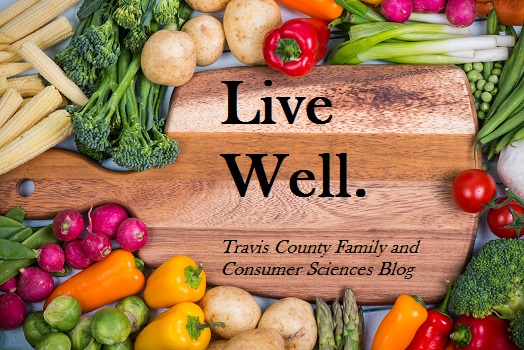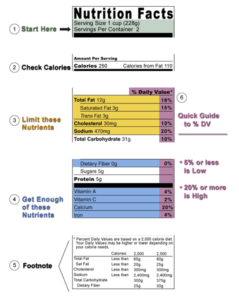By: Amanda Schroeder
Let’s face it; life can be chaotic. Considering all of the responsibilities that we have to juggle each day, who has the time to spend hours at the grocery store? Very few of us! And, if you’re like me, it sometimes feels like a miracle that you even made it in the first place! So, firstly, congratulations for making healthy eating a priority and resisting the fast food temptations. (Yay!) Since you’re so busy, it might be easy to convince yourself that you don’t have the time to check the Nutrition Facts Label for each item you purchase. But it is so important to be aware of the types of nutrients you’re putting into your body, especially if you’re trying to make changes to your eating patterns. Learning how to successfully and quickly interpret the Nutrition Facts Label will make sure you’re able to maintain your healthy eating habits without spending an eternity at the store.
Let’s take a look at a sample label for macaroni and cheese and evaluate the information.
Serving Size
This part seems pretty self-explanatory, but the serving size can be the sneakiest part of the label! You must remember that the facts displayed on the label are true only for the specific serving size listed. In this case, the serving size is 1 cup of macaroni and cheese. If I’m really hungry and I decide to eat 2 cups, then the numbers represented must all be doubled to be accurate. This is how the manufacturers of processed foods trick us! Have you ever looked at the serving sizes of certain not-so-good-for-you packaged foods? Some of them are smaller than the amount most people will consume in order to make you believe the food item is healthier. (How rude, right?!) For example, the serving size for toaster pastries is just one, even though they come in packs of two. Breakfast cereals usually note a serving size of ½ – ¾ cup. Is that how much you’re actually eating? I know I usually eat more than that! There are so many more examples, but the point is to pay attention to the serving size and be realistic about how much you or your family will actually be eating. It not only affects how you read the whole label, but it will help you decide how much to purchase.
The “Meat” of the Label
This is where you determine if a food item fits into your healthy eating goals. Hopefully, you have already set yourself up on SuperTracker and have an idea of how many calories and how much of each nutrient you should aim to consume each day. (Click here to make your profile, if you haven’t already.) Everyone has different needs based on factors like height, weight, gender, and age, particularly for calories. The FDA defines a low calorie item as containing 40 calories or less and a food item is deemed high in calories if it contains 400 or more. Eating too many calories on average can lead to weight gain and obesity.
If you’re still not into the idea of tracking your food, labels also provide a “Percent Daily Value” column for most nutrients to simplify the information even further. But, keep in mind that these numbers are based on the average recommendations for a 2,000 calorie per day diet, so they might not reflect your particular needs exactly. Even so, they’re a quick way to evaluate the numbers presented on the label. It can be hard to know exactly how many grams or milligrams of a particular nutrient is considered high or low, so you can use these percentages to assist you until you feel more comfortable with your personal goals. The FDA defines a food as high in a particular nutrient if it has at least 20% of your daily value and low if it contains 5% or less.
You might notice that there is no percent daily value for trans fat, protein, or sugar. There are a few reasons for that. The value is missing from trans fat and sugar content because it is recommended that we keep the consumption of these nutrients as low as possible. (As far as sugar is concerned, it is especially important to limit added sugars, which will show up on the ingredient list. We’ll touch more on that later!) Even though it is essential to our health, the percent daily value is missing for protein because we typically consume much more protein than we need. We eat so much more that the percentage is not required on the label. This means that, as long as you are eating a balanced diet with an adequate number of calories for your frame and age, you don’t even have to think about getting enough protein. If anything, you might want to become more aware of how much you’re consuming and evaluate whether or not you should cut back, especially if you’re eating high-protein foods at every meal.
According to the FDA, we should all try to limit the nutrients highlighted in orange. The percentages given for total fat, saturated fat, trans fat, sodium, and cholesterol refer to the accepted maximum daily intake, not the daily goal. For example, our macaroni and cheese contains 12 g of total fat per serving, which the label shows to be 18% of our daily value. This doesn’t mean that you should aim for 65 g of total fat every day! Instead, the percentages for these items give you an idea how close the values are to the maximum daily intake, which you should try not to exceed.
Limiting these nutrients could reduce your risk of chronic diseases, like high blood pressure, certain cancers, or heart disease.
On the other hand, we should all aim to consume 100% of the nutrients highlighted in blue. Most of us struggle to reach the proper amounts of these each day. Adequate fiber intake ensures healthy bowel functions and vitamins and minerals each have their own functions which are essential to your body. (Learn more about the importance of specific nutrients in our weekly Micronutrient Monday posts!)
Ingredients
Since we’re talking about the label, let’s talk a little about the ingredients list, too. Each ingredient is listed in descending order by weight, so the first items in the list account for more of the total product weight than the last items. This can be important in determining the integrity of the product. If you’re buying blueberry muffins and blueberries show up last on the list, you might want to question that delicious blueberry flavor! In addition, this is where you can see if the product has added sugars. Some common names to look out for are high-fructose corn syrup, corn syrup, maltose, sucrose, dextrose, fruit juice concentrate, honey, and maple syrup.
The ingredients list is also where to look if you are avoiding or allergic to any common ingredients. To make it simple, the FDA requires manufacturers to specifically highlight any ingredients from its eight determined major food allergens. These allergens include milk, eggs, peanuts, soy, tree nuts, wheat, shellfish, and fish. Manufacturers may either place the allergen in parentheses after an ingredient (e.g. whey [milk]), or they may include an allergen list next to or after the ingredients list (e.g. Contains Milk and Peanuts). This requirement allows you to determine if the ingredients in a product are suitable for your particular needs much more easily and efficiently.
Overall, reading the nutrition facts label might seem tedious, but it gives you a much better chance to maintain the healthy habits that are important to you. There are literally hundreds of processed food options at the grocery store, and they can be full of garbage! It’s important to aim high for micronutrients and fiber; aim low for saturated fat, trans fat, sodium, and cholesterol; and be aware of what you’re putting into your body. If this all seems complicated, there is good news! The produce section doesn’t even have labels! Focus on eating more fruits and vegetables and you will have ample time to evaluate the nutrition facts labels of any other foods you purchase.
Check out the 2015-2020 Dietary Guidelines for Americans for more information on the USDA’s healthy eating recommendations.
References
- http://www.fda.gov/Food/IngredientsPackagingLabeling/LabelingNutrition/ucm274593.htm
- http://www.eatright.org/resource/food/nutrition/nutrition-facts-and-food-labels/the-basics-of-the-nutrition-facts-panel
- http://www.fda.gov/Food/ResourcesForYou/Consumers/ucm079311.htm
- http://health.gov/dietaryguidelines/2015/guidelines/chapter-1/key-recommendations/

